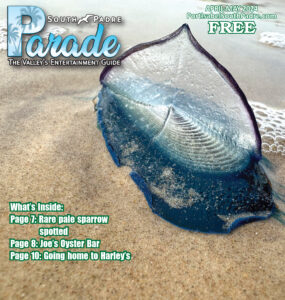By STEVE HATHCOCK
Special to the PRESS
“He had 20-20 vision and could run like a lizard at the age of 102,” Tolbert wrote, “and he had a good thing in his role of South Padre Island Resident Character. For a small fee, he showed up at resort openings and seemed to be able to sniff out the best cocktail parties. He was even featured in real estate advertisements as the “Last of his kind”.
Was the old Indian really the last of his kind?
In the May 8, 1958 issue of the Daily Courier in Connellsville, PA, a reporter Ed Koterba had the following to say about the man he would come to know as Old Indio Joe: “One day, perhaps it was 33 years ago Emile Guerra appeared on Padre Island on the southern rim, that part that looks out at Mexico. That’s just the way it was, he simply appeared mysteriously and he’s been here ever since. Most folks around here refer to Emile as Old Indio Joe. They like to have the Indian around because he adds to the legendary air at this booming retreat across Laguna Madre at the southern tip of Texas.”
Al McGehee, who managed Isla Blanca Park, had this to say Emile’s colorful past. “He’s one of the last survivors of the Karankawa tribe that once roamed this curving needle of sand that reaches 110 miles north to Corpus Christi.”
What an excellent description of our Island Paradise)
That night Koterba went to Emile’s shack and rattled the screen door. Through the mesh he could make out what looked like veils draped across the entire interior.
“You wait’um please,” a graveled voice from within implored “Me fill pipe first.”
Joe’s pipe was like an extension of his being and the old man was never without tobacco. “I come from Houma (Louisiana) 40 years ago on horseback,” said Joe, “I take boat to Lake Charlie then I go to Corpus Christi.”
Then he said he spent some time on a fishing boat to Mexico…. and then his voice dwindled and he never did say how or why he came to South Padre. McGehee theorized that “perhaps one of Joe’s ancestors had been carried off by Mexican slavers. Old Joe, in the uncanny way of Indians found his way back.”
However he ended up here, it was apparent to Koterba that the old timer was not ready to leave anytime soon.
“You couldn’t have budged him from this island retreat with an atomic blast,” Koterba wrote with confidence. (The reporter might not have so readily made that claim if he only knew how close Padre Island had come to being ground zero for the first atomic bomb test just a short 13 years earlier).
What Koterba had at first taken for veils hanging in Old Indio’s shack turned out to be throw nets that Old Indio had knitted with wooden tools of his own crafting.“His nets were masterpieces,” Koterba reported, “and he also makes a bit of money going out into the shallow water and feeling with his bare feet for oysters, which he gathers by the bucket. He shucks them and sells them by the quart to resort kitchens. The Coast Guard boys took to him like a father, gifting the old man with shirts that hung in layers upon his diminutive frame. There were even eleven pairs of cast off boots lining the wall near the foot of his bed.”
His days, for the most part, were a series of travels that took him about the Island he called home. Mornings and evenings he would sip coffee and sew nets along a wooden counter at the Coast Guard Station. During the day he would cast about searching for his daily fare, which could be anything from the fish he caught himself, a fine meal served up by a willing cook at the Station or at one of the resorts where, as a regular attraction, he was provided for.
For the curious archaeologist, Emil said the last Karankawa Village, now surely covered by dunes or perhaps lying exposed along the edges of a mudflat, was located about 37 miles up the coast from the Brazos Pass which would put it 11 miles or so north of where Padre Balli built his mission and just a few miles south of the Devil’s Elbow.
An excellent oil painting of Old Indio by an unknown artist, hung in the front lobby of Ward McCreedy’s El Padre Motel but it vanished sometime before Bud and Connie Wiechman assumed management in the late 1960s.
Eventually even Old Indio could no longer resist the corrosive effect of time. His vision left him as did his health until all he had left were his memories. Did he wander up the Island one last time only to never return? Or did he die in his bed somewhere on the Island or in nearby Port Isabel? Though I have not been able to find his obituary, Old Indio’s spirit has carried forward and today he is part of the legend of Padre Island.
Want the whole story? Pick up a copy of the Port Isabel-South Padre Press, or subscribe to our E-Edition by clicking here.


Comments